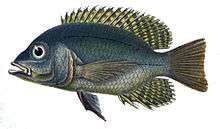Chaetobranchini
Chaetobranchini is a tribe of the subfamily Cichlinae, the American cichlids. They are distributed from the river basin of the Orinoco and the Guianas south to the basins of the Río Paraná and Río Paraguay . The two recognised genera of the Chaetobranchini have been classified together with Astronotus in the subfamily Astronotinae but the consensus is that this genus forms the monogeneric tribe, the Astronotini, these two each being one of the seven tribes in Cichlinae.[1]
| Chaetobranchini | |
|---|---|
 | |
| Chaetobranchus flavescens | |
| Scientific classification | |
| Kingdom: | Animalia |
| Phylum: | Chordata |
| Class: | Actinopterygii |
| Order: | Cichliformes |
| Family: | Cichlidae |
| Subfamily: | Cichlinae |
| Tribe: | Chaetobranchini Fernández Yépez, 1951 |
| Type genus | |
| Chaetobranchus Heckel, 1840 | |
Characteristics
The species in Chaetobranchini grow to lengths of 12–24 centimetres (4.7–9.4 in) in length and have an oval, laterally compressed body with a pointed head. They have small mouths and teeth, feed on plankton using filaments on their gill arches as a filter.[2] The chaetobranchins possess a very reduced lower pharyngeal jaw which has elongated lateral processes, a keel and conical teeth.[3] Chaetobranchines are also characterised by their long pointed pectoral fins, which extend alsmot to the end of the base of the anal fin and the three or four long posterior lateral lines which reach to the caudal fin.[4]
Genera
The two genera included in the Chaetobranchini are:[1]
- Chaetobranchopsis Steindachner, 1875
- Chaetobranchus Heckel, 1840
References
- Wm. Leo Smith; Prosanta Chakrabarty; John S. Sparks (2008). "Phylogeny, taxonomy, and evolution of Neotropical cichlids (Teleostei: Cichlidae: Cichlinae)" (PDF). Cladistics. 24 (5): 624–641.
- Gisele C. Novakowski; Fernanda A. S. Cassemiro & Norma S. Hahn (2016). "Diet and ecomorphological relationships of four cichlid species from the Cuiabá River basin" (PDF). Neotropical Ichthyology. 14 (3): e150151. doi:10.1590/1982-0224-20150151.
- Edward D. Burress (2015). "Cichlid fishes as models of ecological diversification: patterns, mechanisms, and consequences". Hydrobiologia. 748: 7–27. doi:10.1007/s10750-014-1960-z.
- Sven O. Kullander (1983). "Part II Review of the South American Cichlidae" (PDF). svenkullander.se. Retrieved 15 November 2018.